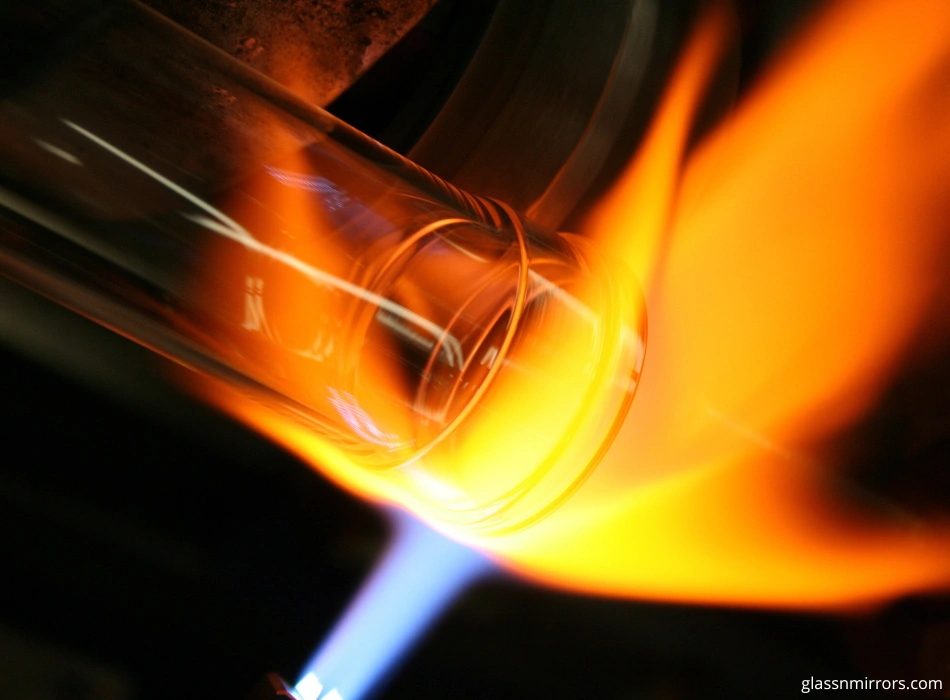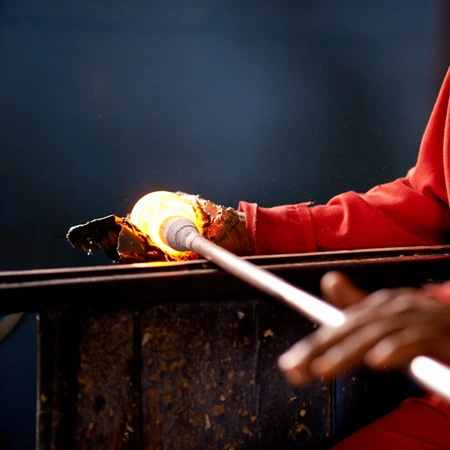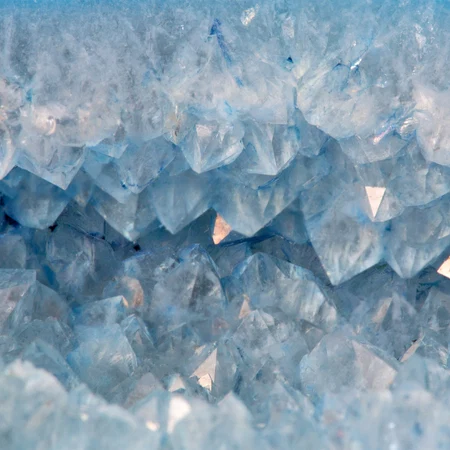Even though technology has improved, you may have heard of a glass door suddenly breaking with a loud pop and a smashing sound. There have been many reports of windows and balconies breaking and falling from high-rise buildings in different places across the world. Though rare, these accidents pose risks that lead building code writers, architects, government officials, and other professionals in the industry to rethink which types of glass should be used. Can heat break glass?
Rapid changes in heat can break glass, which is a poor thermal conductor. Rapid heat changes cause stress on thin glass which later starts fracturing. As the temperature rises, glass can break at about 302 – 392°F (150° Celcius).
Architects and specifiers need to know all possible reasons why glass breaks on its own and some common misconceptions about how spontaneously it breaks. When people talk about “safety glazing,” they usually mean any glass made to make it less likely that people will get hurt if they touch it.

Even though no regular pattern has been found, most of the people whose windows broke say it was because of changes in temperature at the time it happened. I have done intensive research to find out the relationship between heat and glass breaking. So, “can heat break glass?”
Heat has varying effects on glass at different temperatures. I will answer some of the most common questions about the impact of heat on glass in this article; among them are the temperature at which glass breaks among other concerns.
Table of Contents
- 1 At What Temperature Does Glass Break?
- 2 At What Temperature Does Glass Crack?
- 3 Will Tempered Glass Break from Heat?
- 4 Advantages of Tempered Glass over Annealed Glass
- 5 What Causes the Hardened Glass to Shatter?
- 6 Can Glass Break from Fire?
- 7 What Happens to Glass When Heated?
- 8 What Causes Glass to Shatter by Itself?
- 9 Final Thoughts – Can Heat Break Glass?
- 10 Hot Glass vs Cold Glass – What’s The Difference?
- 11 Can Quartz Be Made Into Glass? Guide On Quartz & Glass
- 12 What Is Panda Glass | Ultimate Guide To Panda Glass
- 13 What Is A Vanity Mirror – And Which One You Should Pick
At What Temperature Does Glass Break?
Glass is most likely to break as the temperatures increase to and above 302° F (150° C). There are several factors that can cause the glass to break independently and that include thermal stress.
With thermal stress, the glass will expand with an increase in temperatures. The expansion makes internal flaws or impurities like nickel sulfide create an imbalance in its structure, which leads to its breaking when it reaches its breaking point. These changes often affect ordinary glass as opposed to tempered glass.
Also, a combination of temperature and pressure causes the glass to break. The main effect of heat is the “freeze and thaw” action, which is the rapid shifting in temperatures. As a result of its poor heat conductivity, glass is susceptible to stress fractures that may lead to its eventual breakage.
When heated to 390 degrees Fahrenheit, the thin glass begins to break. An excessively intense heat source (e.g., 500°C) can cause a glass container to lose shape and change into plastic.
At What Temperature Does Glass Crack?
The temperature at which glass cracks will depend on the speed you heat the glass, meaning there is no specific cracking temperature. Several other factors contribute to the cracking or shattering of glass.
No particular temperature is necessary; if heated uniformly, the glass will not crack even at extremely low temperatures, and it will remain intact as the temperature rises until it melts. Is it feasible to have a significant differential in temperature between one end and the other or between one side and the other? As a result, glass is very likely to shatter.
If you fill a glass halfway with ice-cold water before adding boiling water. Differential heating or cooling does not generate as much stress while moving from a low-temperature zone to a high-temperature zone because “Pyrex” (a trademark for low thermal expansion glass, but a different type as before) does not expand contract as much.
The following ways can help prevent the cracking of glass from these factors.
- Heating glass dishware or household glass evenly and slowly for uniform expansion.
- Applying unique color or coating on glass patio or panel doors to slow or distribute heat evenly.
- For glass doors and window panes, you can add an outdoor shade to provide some shade and minimize direct heat.
- If glass dishware gets too hot, avoid pouring ice-cold water suddenly.
Will Tempered Glass Break from Heat?
Tempered glass is strengthened by heating to make it more resistant, but it can still break from thermal stress as a result of sudden temperature changes. Tempering glass means heating it beyond its soft point which is 600° Celsius.
The glass is then rapidly cooled to create a high surface compression and edge compression. Volume, air-quench temperature, and other variables lead to a surface compression of not less than 69 MPa or 10,000 psi.
Tempering glass makes it over four times stronger than standard or untreated glass. As much as tempered glass can break from the heat or thermal shock, the risk is lower than untreated glass.
The tempering process may result in slight optical distortions by slightly modifying the original flat shape of annealed glass. The modification, commonly known as “glass warp or glass bow, ” results from glass moving horizontally in the tempering oven rollers.
Advantages of Tempered Glass over Annealed Glass
Tempered glass has more benefits compared to annealed glass and simply heat-strengthened glass.
- Tempering provides a higher resistance to thermal and mechanical impact on the glass than heat-strengthened or ordinary glass.
- Tempered glass has approximately four times mechanical and thermal strength as annealed glass.
- Tempering glass retains all the properties in an annealed glass, such as chemical composition and resistance, expansion, deflection, and hardness, except breakage and standard strength properties.
- The breakage of tempered glass is much safer than annealed glass as it breaks into numerous small dices. Regular glass breaks into large sharp pieces.
The second after the fully tempered glass is the heat-strengthened glass, which is more resistant than annealed glass.
What Causes the Hardened Glass to Shatter?
From time to time, hardened glass has been known to shatter, seemingly without explanation. This is known as spontaneous glass breakage and is, an indisputable fact, often produced by one of four factors:
- Microscopic internal flaws within the glass, such as nickel sulfide inclusions.
- Minor damage during installation, such as nicked or chipped edges, eventually evolves into significant breaks.
- The overly tight binding of the glass in the frame causes strains to develop as the glass expands and contracts due to heat changes or deflects owing to the wind.
- Inadequate glass thickness to resist wind load.
You can avoid some concerns such as installation damage and poor fitting by employing qualified glass specialists. But preventing glass that includes nickel sulfide from thermal breaking can be a challenge. Preventing these effects is hard as the impurities come from manufacturing the glass plate.
Plate glass is heated up to its usual softening point during the tempering process, then rapidly cooled. The surface cools quicker than the inside glass, providing the central tension that gives toughened glass greater strength. However, quick cooling locks any nickel sulfide inclusions in an unstable form.
With time, these inclusions will change to their stable, extended state. This expansion can develop a weak area in the hardened glass and sometimes cause the glass to break suddenly later.
Can Glass Break from Fire?
Glass can be broken from fire due to the deep gradient called thermal stress. The rapid temperature change is what scientists calls thermal shock. When there is a fire, the glass window pane experiences an intense heat flux on one side.
The heat creates a sharp thermal gradient across the glass’s thickness. During the fire, thermal stress concentrates on the central part of the pane. Thermal heat in the form of thermal radiation travels across the glass pane. The edges lose heat energy through the pane by conduction.
In the process, the central region starts to expand due to the heat intensity, and the edges remain cooler and induce stress on the glass pane. It is this shifting gradient that causes the glass to break.
Even with uniform heating, the glass sides will remain cooler than the center. It is because the heat on the sides disappears into the window frames leaving the sides cooler.
Fire breaks glass in the following pattern.
- The glass first cracks from the intense central heat.
- The cracks begin from the glass sides that are fitted between the thick frames. The time frame between the cracking and complete breaking or shattering of the glass depends on its type and the nature of the fire.
Glass does not break from a fire at the same temperatures; some glass types have more resistance capabilities than others.
What Happens to Glass When Heated?
Due to thermal gradients and angularity, thick glass is more vulnerable to fracture during rapid heating. Because of the reduced likelihood of thermal gradients forming during fast heating, thin-walled glass is more resistant to hot water.
Another thing is the annealing of glass. This is the process of freezing a piece of glassware after being molded in a mold to eliminate stress. Glass behaves like a super-thick liquid as long as the temperature does not surpass the point at which softening occurs.
Therefore, slowly heating and then chilling the glasses can help alleviate stress. Unresolved tension is referred to as “residual stress.” By measuring the thickness of a piece of glass and looking for residual strains, cross-polarized light can reveal just how much stress is still present in the material.
Using bottles that haven’t been annealed long enough can result in significant failure rates after the glass manufacturer. Thermal shock fracture failures can occur when the annealing step of the glass manufacturing process is rushed.
There are some processes to fuse glass by heating; below are some of them.
- Slumping
The slumping process means molding a piece of glass, and it requires about 1200 to 1250 degrees F. On reaching these temperatures, glass becomes soft enough to mold or shape. While slumping is molding a piece of glass, draping refers to allowing a piece of glass to drape over a mold and create the desired shape.
- Polishing by Heat
The glass surface becomes soft enough to melt when you heat it to about 1300 to 1350 degrees F. You can come up with a smooth, shiny glass by heating it to a point where only the surface melts. These temperature ranges also smooth out any rough edges without distorting the original shape of the glass.
- Tack Fusing
Tack fusing glass happens at 1350 to 1375 degrees F, and it involves heating two or more pieces of glass together. At this temperature range, the glass pieces in contact will fuse with each retaining its original shape, thickness, and size.
- Contour Fusing
The glass pieces start to melt and form a single piece as the temperature exceeds the tack fusing range. The glass will not melt completely, but it will begin flowing into a single glass without retaining any original sizes, shapes, or thickness.
It takes place at about 1400to 1450 degrees F. The finish will be polished, but it will not have a smooth, uniform shape.
- Casting
It is the process of putting various glass pieces together into a mold and heating them at a high temperature. It requires approximately 1475 to 1500 degrees F to shape the glass. The mold is similar to that of creating figures and pottery. The cast pieces are ideal for creating adornments through fusing.
- Kiln Pouring
It is the process of heating glass into a liquid form that pours or flows freely. The technique requires a deep glass kiln and approximately 1600 to 1700 degrees F.
- Full Fusing
Full fusing changes several pieces of glass into a single piece with uniform thickness. It happens from 1450 to 1475 degrees F. These temperatures cause the glass to melt enough to flow together uniformly.
What Causes Glass to Shatter by Itself?
Sometimes, glass can just shatter by itself or without any reason. This is also referred to as spontaneous glass breakage.
Glass can shatter by itself due to thermal shock or thermal stress, manufacturing defects such as the inclusion of nickel sulfide (which happens rarely), and when the glass has an inadequate thickness to resist pressure from the winds.
Final Thoughts – Can Heat Break Glass?
Heat has a significant impact on glassware. If you have glass doors in high-traffic places like the patio, it is necessary to shield them from extreme temperatures to boost their durability.
It would also help to be careful when purchasing glass dishware and other items to select the best quality with more heat resistance. You may opt for tempered glass or heat-strengthened. Purchasing glass with a heat-resistance coating will also save you losses from glass breaking from heat.

Hot Glass vs Cold Glass – What’s The Difference?

Can Quartz Be Made Into Glass? Guide On Quartz & Glass

What Is Panda Glass | Ultimate Guide To Panda Glass


3 thoughts on “Can Heat Break Glass? Temperature & Fracturing Explained”
Comments are closed.